One day, the war ended. And Jack Prince didn’t come home.

He didn’t walk through the door of 88-11 247th Street as he might have done in 1945, with a row of ribbons on a forest-green uniform coat telling a silent story of all he’d seen and done. He never saw his hometown with a grown man’s eyes; eighteen when he left, he’d have been twenty-one in ‘45, old enough to amble down to the local VFW post – which would be named, no doubt, for another dead Bellerose boy – and share a beer or something stronger with other grown men who knew what he had been through without having to ask. He didn’t get to thank Grace for the gift and show her how he’d worn it every day, until he could put it in a jewelry box or a foot locker for the day his kids (maybe their kids) found it and asked what it was.
Jack didn’t come home with scars, on crutches, missing an eye or an arm, hair prematurely graying, prone to bouts of rage, drinking, depression, or silence. And he didn’t come home with an escort, carried into the living room by four somber Marines, laid in state for friends and family who knew him as he was to say goodbye, to go with him to a cemetery and leave flowers on Memorial Day.
Jack just didn’t come home.
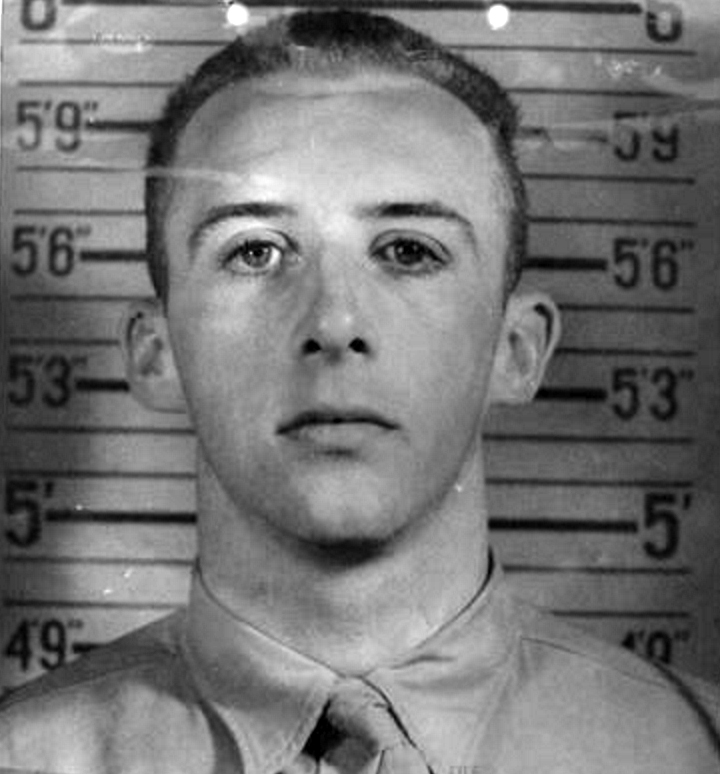
One year to the day after he left Bellerose to enlist, Jack was buried on Betio with forty other men, Grace’s gift on his wrist, a bullet in his body, and a stick driven into the ground by his head, marking the resting place of
PFC
John F Prince
502466
Nov 20 1943
and there he stayed as the marker moved, the cemetery vanished, the cases closed and the questions remained. Killed in action. Body not recovered. Lost at sea, his family and friends were told, and gradually they came to believe and accept the story.
Until seven decades later, when the story changed.
I remember the day when John F Prince (USMC) was posted as KIA in the Long Island Press, our local newspaper. What I did not know was that he was classified as missing and never received a proper burial.
– Herb Heinlein
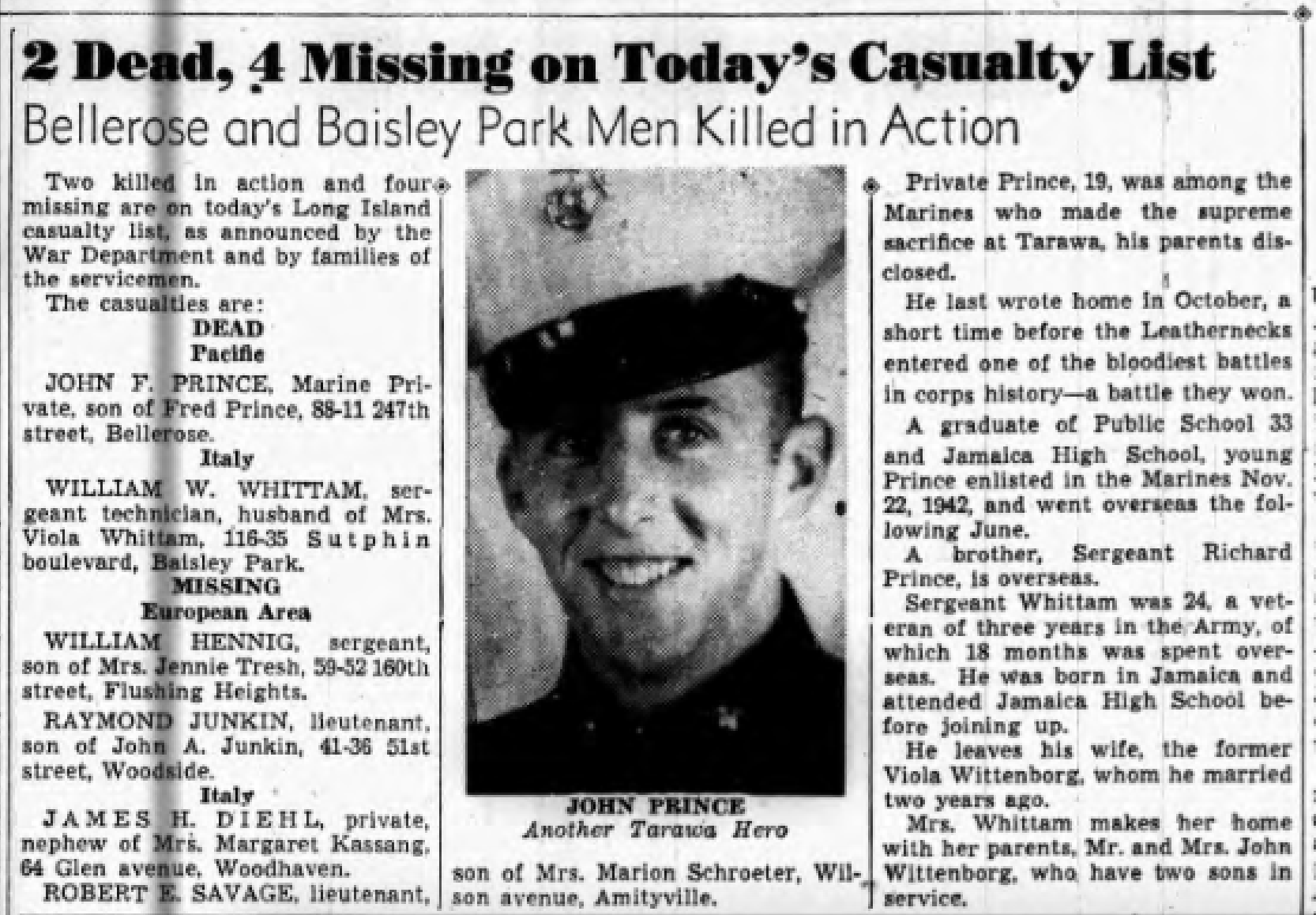
I arrived sat the appointed place long before the appointed time on Friday, June 17. The woman at the visitor’s center helped with the directions. Section 25, down Garfield Langhorn Road. They’ll have chairs set up. Should be lots of people, you really can’t miss it.
So off I went, driving slowly on this sunny summer day, past the immaculate green fields and perfectly spaced graves of Calverton National Cemetery, past the occasional parked car, past people walking slowly down the long rows, or looking contemplatively at a particular grave, or putting down some flowers. I didn’t know what I was looking for until I found it. No crowds, but the chairs were there, and a gravestone leaning on a padded support.
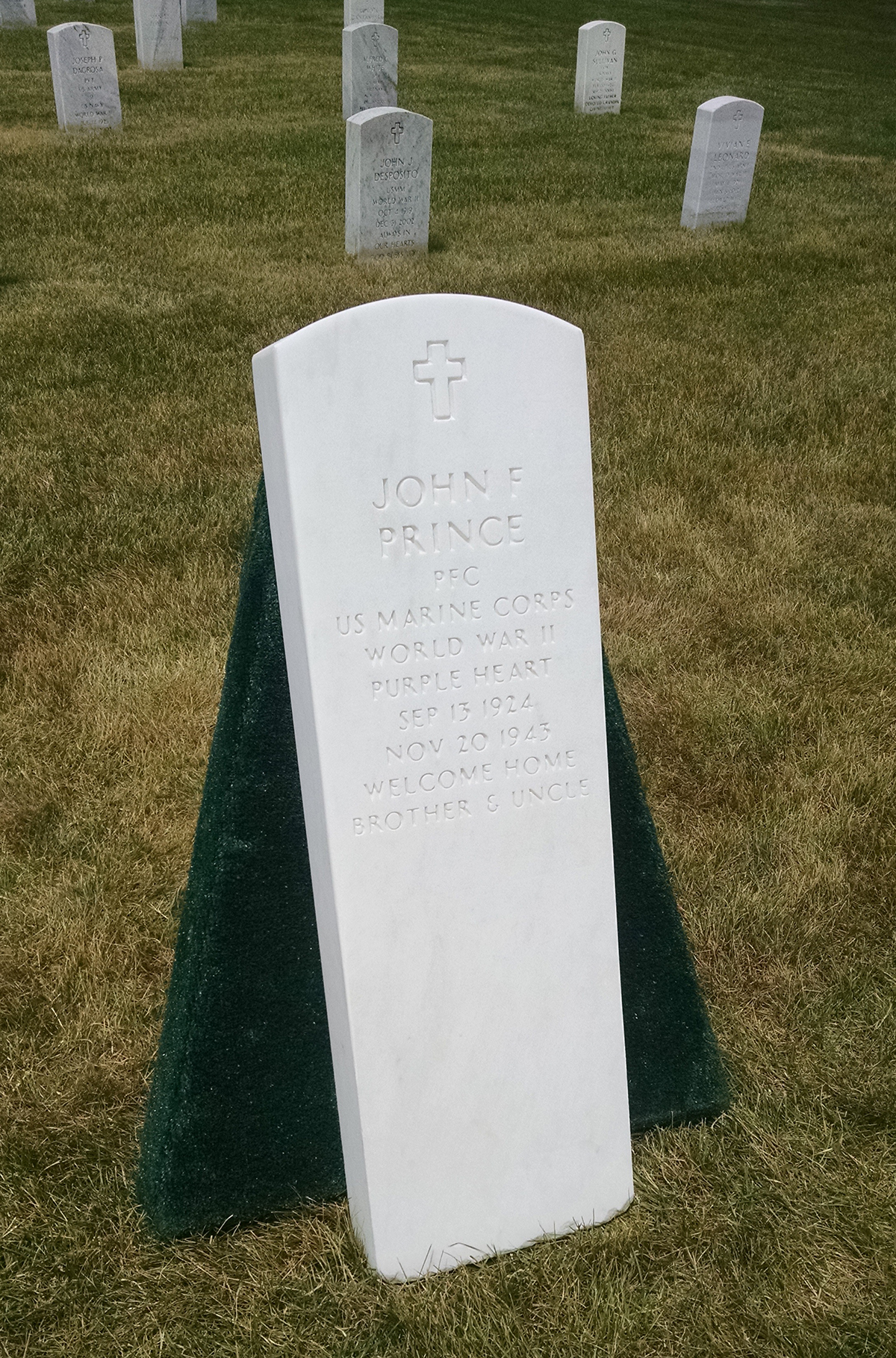
Until a few months ago, John Frederick Prince was just another name in my database, one of hundreds tagged with “Tarawa” and an old, hopeful note reading “JPAC investigation pending.” Nothing ever came of JPAC’s “investigation,” of course, and JPAC is no more. But thanks to the work of History Flight, and the persistence of Clay Bonnyman Evans, a real investigation took place in 2015. Mr. Evans’ grandfather, 1Lt. Alexander Bonnyman, was found buried beside 34 other Marines. Suddenly, the location called “8th Marines Cemetery #2” seemed full of promise – and so it proved to be, as one name after another was returned to the long anonymous bones. John Prince was announced in April, 2016; shortly thereafter, Jennifer Morrison of History Flight mentioned that the burial would take place on Long Island. A two-hour drive, but closer than any other thus far, and so I decided to attend.
I didn’t know quite what to expect – after five years of work on MissingMarines, I had never yet been to a recovered Marine’s funeral. As a total stranger to PFC Prince’s friends and family (save one gentleman, Herb Heinlein, whom I have never met in person) I decided to forego the memorial service, figuring it would be a personal affair. I would go to the cemetery instead, watch the funeral from a respectful distance, perhaps meet a few people, and get to pay my respects. And at first it seemed the burial itself would be quite intimate – if anyone showed up at all. Only one other person was there, taking pictures of the gravestone with a professional camera. She introduced herself as a photographer from the AP and asked “The ceremony starts at 1:30, right?”
“Yes, I think that’s right,” I replied, having no idea. If she was right, we were in for a long wait. But – if the Prince family could wait for 72 years, what was two hours on a beautiful afternoon?
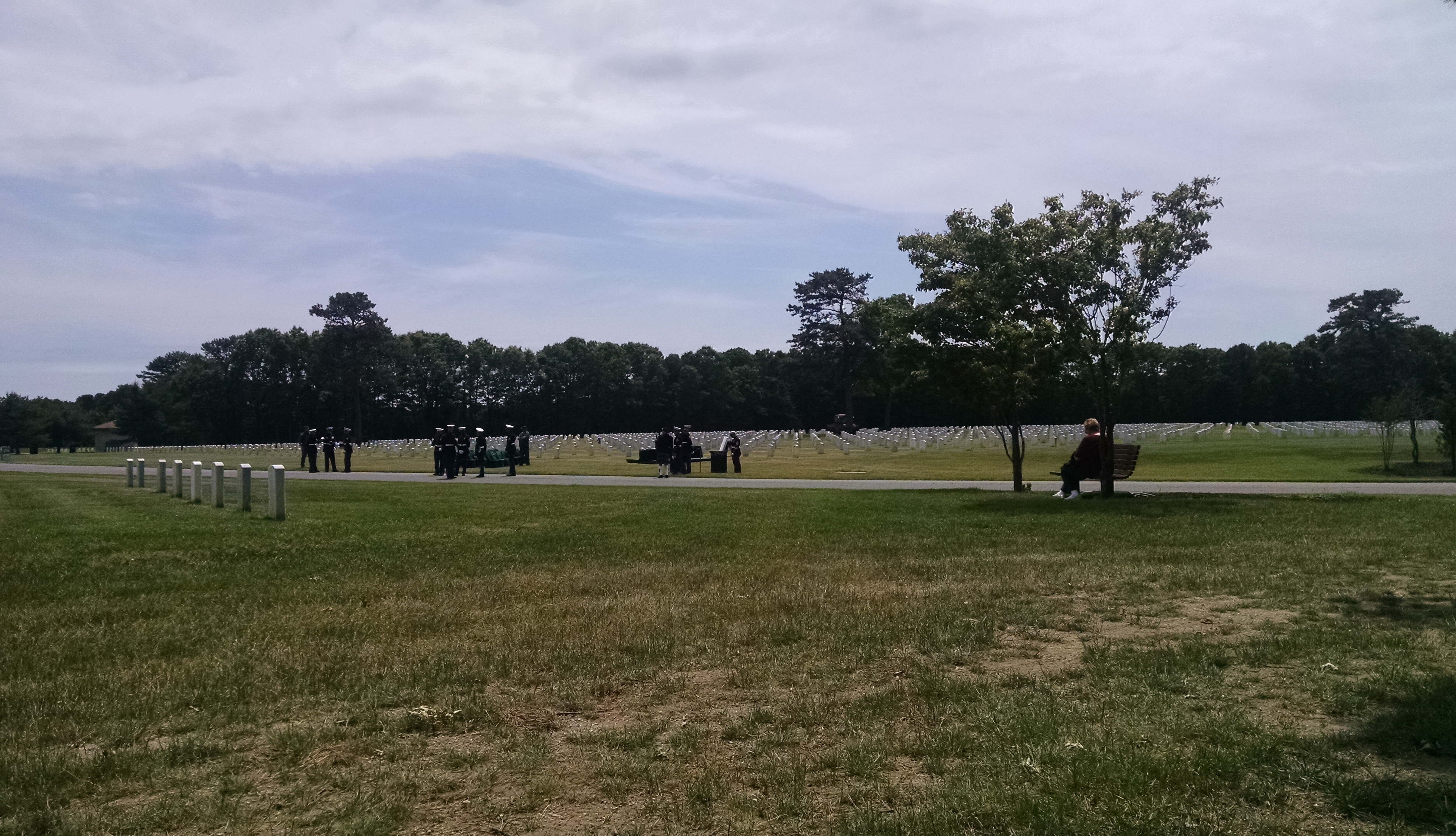
As time passed, more vehicles started to arrive at the gravesite. Most contained uniformed Marines who would make up the honor guard and actually perform the ceremony; those of us not in uniform watched their rehearsals with interest. A handful of cars, most bearing Marine Corps stickers, also parked nearby; their drivers, older men, sported the Eagle, Globe and Anchor on caps and shirts. A bagpiper tootled his way through Amazing Grace and the Marine’s Hymn, starting off uncertainly but gaining in confidence with each rehearsal. Flag-bearing, vest-wearing volunteers – members of Rolling Thunder, I thought – pulled up on motorcycles, piled out of vans, and took their places around the gravesite. I felt like something of an intruder. What was I, a suit-wearing civilian with no personal connection to this family, doing here? When asked, I said I had done research into the Tarawa MIAs, which seemed a satisfactory answer – but still, I scoped out a spot under a tree on a hill where I could watch without getting in the way.
I was showing the layout of the 8th Marines cemetery (reproduced in Tarawa’s Gravediggers) to the bagpiper’s wife and a Marine platoon sergeant when the bagpiper called out, “Here they come!”
We heard the throaty motorcycle engines before we saw them. The ride captain, followed by a handful of bikers, motored slowly down the road. Behind them was a large gray hearse – and behind that, a veritable fleet of cars in a funeral procession that extended down the section and out of sight. The Marines snapped to attention, the volunteers raised their flags in salute, and the hearse pulled to a stop right in front of the grave.
The piper played, the priest struggled into his vestments, and John Prince’s family – perhaps thirty people – gathered around as the Marines reverently pulled the flag-covered coffin from the hearse and moved with slow half-steps towards the green-clothed lowering device standing above the open grave. Everything was done with exaggerated slowness, as if the Marines themselves were moving underwater. It might have seemed comical, but every action was performed with such gravitas that you might find yourself holding your breath instead.

The exception to this rule was the firing squad, seven Marines who snapped off three quick volleys with such precision that one would think only three single shots were fired. The flags dipped, hands went up in salute or over hearts, and the bugler played Taps, letting the final note hang in the heavy air.
My vantage point on the hill was poorly picked. I wound up behind the hearse, unable to see or hear as a man in a suit turned to address the now-seated family. I joined the crowd just as the priest began his invocation; as he invoked the Marine’s Prayer I stole some glances at the bowed heads around me. They were of all ages; some in suits, some dressed less formally, and one young man wore the uniform of a Marine corporal. They seemed a completely ordinary set of people; in fact, they would prove to be extraordinarily kind and welcoming. But as we stood there listening to the priest’s words, two thoughts came to mind.
This could be any family in the country – or, for that matter, the world.
And none of them look old enough to remember the man they’re here to bury.
To those in the relatively small MIA research community, every successful recovery is a cause for celebration. You spend so long looking at photographs of those you’re trying to find, repeating their names over and over, learning and writing about their lives and deaths that it’s impossible not to feel a connection to that individual whom you’ve never met; you feel that you know them, maybe even that you might have been friends, and it’s easy to begin thinking I’m doing this for them. Then, too, there’s the personal vindication – you’ve solved a mystery, you were right, you’ve proven your skills and abilities as a researcher or historian. You stop short of saying I’m doing this for me, but you take pride in yourself and your peers for a job well done.
But to meet the families – who are not so different from your own, who have carried the knowledge of this loss their entire lives, who should have grown up listening to Uncle Jack’s war stories and having his children for cousins – and who have come from across the country for this – that’s when you know who you do this for. Whether or not you believe in the soul, bones are impartial and don’t much care where they lie. The man in the coffin whose life you think you know so well – he was your research project. The people standing around him – on the day he died, they lost more than you or they will ever know, long before you or they were born.
I’ve said many times in the past that one of my reasons for undertaking this project was to bring some closure to the families. Honestly, I’ve said it more times than I can count. Yet I never knew what that really meant, what it looked or felt like, until that Friday afternoon as I stood quietly behind a real family experiencing this event. And, now knowing, I will never say it emptily again. If I had any doubts about wanting to do this work for the rest of my life, they vanished at Jack’s gravesite. And if anyone has any doubts about the importance of these recovery efforts, well, just let them experience an event like this.
Photographs courtesy of Katie Rasdorf.
As the priest concluded his remarks and the family stood to pass by the coffin, a woman in a black dress came over to me – having, I suppose, spotted Tarawa’s Gravediggers sticking out of my jacket pocket. Katie Rasdorf was representing History Flight at the funeral, and I’d been forewarned that she wanted to talk to me about the Tarawa map I’d made a few years ago. With the ice officially broken, she introduced me around to the family (“this is Geoff, he’s got a great database on Tarawa!”), and to Dr. Corinne D’Anjou, the forensic odontologist who had actually gone to Tarawa and done the dental work on the remains from the 8th Marines Cemetery #2. Speaking with them was almost like meeting old friends; we spoke the same language of IDPFs and DPAAs and Red Beaches. After learning that I’d missed the memorial service (“Why? It was open to the public and it was packed!”) Katie decided I should come to the reception following the burial and secured an invite from the family, which I rather awkwardly accepted. (I can be comically graceless when surprised or in unfamiliar and emotional situations; this was a trifecta that culminated in needing directions written out for me because my phone-based GPS and car charger both gave up the ghost on the way to the cemetery. Luckily, as I mentioned before, they are an extraordinarily kind and welcoming group.)
People started moving towards their cars. As the cemetery workers prepared to lower the casket into the ground, and with permission, I placed a World War II-era EGA emblem on top. Only one person saw, a mourner in civilian clothes who said a quiet “Semper Fi” as he turned away.
The reception took place at a hotel in New Hyde Park, with an energetic wedding taking place next door. Corinne and Katie were the heroines of the hour, especially when Corinne told the story of matching John’s teeth to a dental chart, and knowing in that moment exactly who he was.
Just as I was preparing to go, someone rang a glass for quiet. Another of the younger relatives stood up, and announced he would sing “Danny Boy” in honor of Jack. He had a beautiful, clear voice; and while he unfortunately had to compete with David Bowie (courtesy of the wedding next door) his song stilled the room.
But come ye back when summer’s in the meadow
Or when the valley’s hushed and white with snow
I’ll be here, in sunshine or in shadow
Oh Danny boy, oh Danny boy, I love you so.
“I love you, Jack!” he cried to the sky, and his whole family echoed him: “We love you, Jack!”
The song ended… and with that, Jack Prince finally came home.



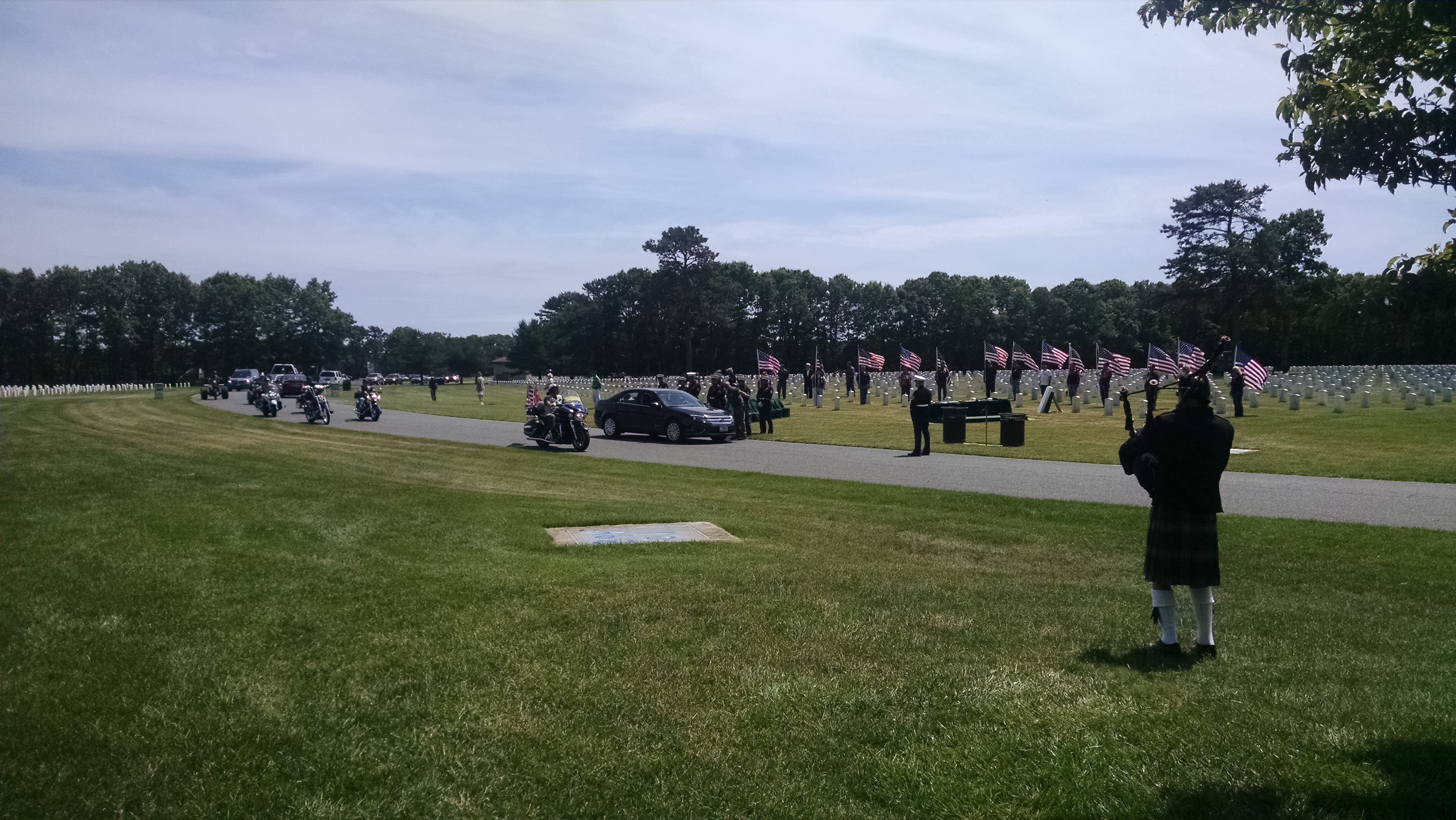






Am so glad to see more marines being brought home, waiting for two in particular from Tarawa. Both are my cousins uncles, and one is my uncle.
We’re waiting with you, Dave! The more I see in the news, the more I believe that if it’s possible for anyone to bring Sgt. Walter Sutherland and PFC John Holm back, it’ll be History Flight.
Thank you, Geoff, for your post honoring my Uncle Jack! You did a remarkable job, not only reporting on the day as it happened, but also in making Uncle Jack’s story very real, and giving him a life story that goes beyond his actual 19 years … Geoff, glad you were at Calverton to see his over-due full military burial (which was awesome!) and to share time with his family, who are so happy to have him home!
Yes, Uncle Jack, it’s been a long time and we have certainly missed you!
Thank YOU, Patricia – and the whole Prince family – for letting me in! The memory of that day will stay with me for a long time.
Wow!
I am part of Burroughs Battery, a civil war horse drawn artillery unit in Knoxville, TN. We were asked by the family to provide funeral caisson honors to Lt. Bonnyman. Our group spent countless hours getting ready for rendering final honors to this hero and his family. It was singularly one of the most proud and moving things I have done in my lifetime. I am honored to have been part of carrying him to a place of honor. The Marines provided the services of their Arlington Honor Detachment. There are a series of videos on our Facebook page showing the movement to his final resting place.
I encourage everyone to read about Lt. Alexander Bonnyman, USMC, MoH and the heroic deeds that he rendered to our nation.
I must say that it is a disgrace that so many lay unknown on a distant island battlefield dishonored by a nation who left them on forgotten and foreign shores. It would be incumbent for the USMC to remember that ethos of leaving no one behind and move heaven and earth to undue such a tragic misdeed to the fallen and their families. Harry Uffalussy
We are still waiting for my great uncle Elmer Leon Martin for whom I was given my middle name From the stories I’ve been told they originally thought another marine was him but it was not to be He is still listed as missing in action and from what I’ve been told he will always be missing I was told that the only way they know he was hit by a mortar was that the chaplain on the beach saw it happen He knew it was my uncle from mass that he attended aboard his ship I did not know my father’s side of the family from whense he came until I was in my twenties and I always wondered why I loved ocean so much It turns out that not only did he see action but his brother, whom was my grandfather, was aboard the USS wasp when it was sank by a jap torpedo He survived and continued his service and made it home after the war We have all thought of our family members who really were part of the greatest generation they are all heros
Russell, Elmer Leon Martin was my uncle. He and my father, William Howard Martin, were brothers. I have letters that he sent (during his deployments) to his girlfriend, Wilma Jean Adams in Shawnee, OK.
It is my understanding that Elmer Leon’s remains may be among those still unidentifief at Punchbowl Cemetery in Hawaii.
My cousin, Dennis Harold Reddick, had submitted a DNA sample to possibly help identify the remains. Dennis’s mother, my aunt, Mildred Martin Reddick, was Elmer’s sister.
My phone number is 817 301-2371. I live in Fort Worth, Texas.
“His Lord said to him, Well done, you good and faithful servant…” Matthew 25:21.
PFC John Frederick Prince was killed by gunshot wounds on 20 November 1943 on Tarawa. In 2011/2012, Chief Rick Stone while a member of the Department of Defense determined that PFC Prince was not a most likely match for any “Unknowns” buried in the Punchbowl. The Chief Rick Stone and Family Charitable Foundation researchers, using advanced law enforcement techniques and sophisticated technologies not available at JPAC, confirmed that PFC Prince was not a match to any Punchbowl Unknowns and submitted a report to JPAC in 2013 noting his likely burial in Cemetery 27 on Tarawa, also known as the “Lost Cemetery”. During a construction project in 2015, Cemetery 27 was finally discovered on Tarawa. PFC Prince was recovered from Cemetery 27, long hidden underneath a parking lot on Tarawa, and officially identified in April 2016. Welcome home Marine! We share the joy of your family in your return! God Bless you and thanks to ALL who never forgot you and your service to our country!